"When once you have tasted flight, you will forever walk the earth with your eyes turned skyward, for there you have been, and there you will always long to return." -Unknown
Someone showed me a picture yesterday, and my initial reaction was simply, "WOW!" See for yourself:
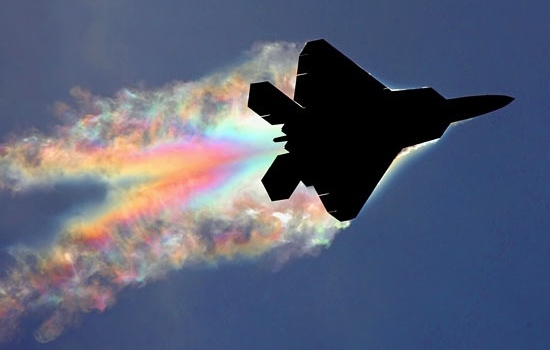
But, as a physicist, I look at something like this and I immediately need to figure out what's going on here.
First off, you notice that this is clearly some type of fighter jet, being photographed from below with the Sun illuminating it from above. A little google-fu reveals that the silhouette matches that of an F-22 Raptor.
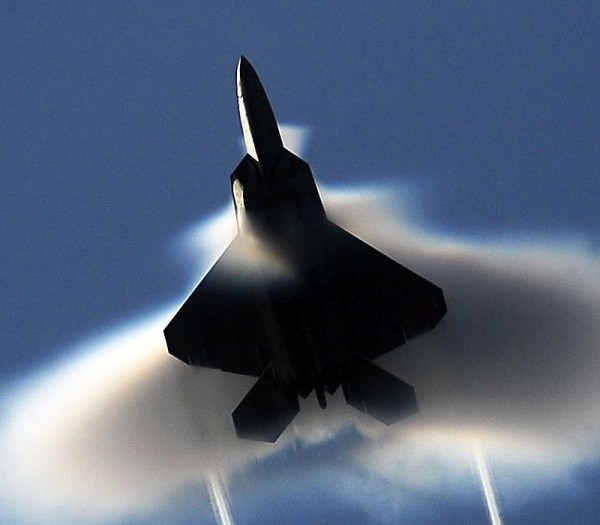
This plane is easily capable of supersonic speeds, and I wouldn't be surprised if its speed wasn't exceeding (or at least approaching) Mach 1. The fact that we're moving somewhere around the speed of sound is important, and we'll need to remember it for later.
But the star of the top picture is clearly the rainbow trail behind it. Most of you have seen such a rainbow trail before, similar to when you have the Sun shining on a film of soap or oil in a puddle on the street.
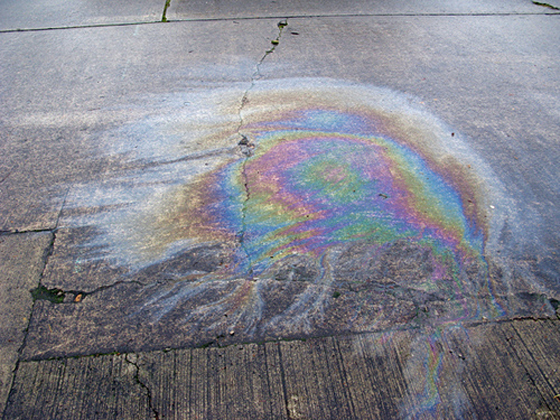
But the thin-film rainbow, above, caused by light refracting into the oil, reflecting off of the water beneath, and then making it to your eye, likely doesn't have anything to do with the one we're seeing. The closest thing we have to what's going on, coming in at number 8 on a list of top 10 strangest natural phenomena, is the Fire Rainbow.

The Fire Rainbow happens when you have high-altitude sunlight (58 degrees or higher) hitting special types of ice crystals known as hexagonal plate crystals, found naturally in very-high altitude cirrus clouds.
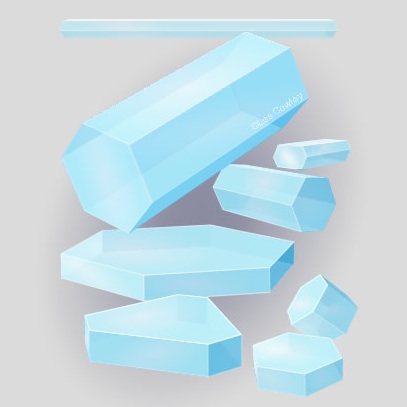
The light enters through the top face of a horizontally-oriented hexagonal crystal and leaves, after some internal reflection(s), through the bottom face. It produces a spectrum of colors, visible only to an observer who sees the ice crystals at an angle of 46 degrees.
But what's going on with the plane is an incredibly special example of this.
Now, did you remember that this fighter plane was moving close to the speed of sound? When an aircraft approaches the speed of sound (Mach 1), the air pressure above the wing becomes very, very tiny, and the airflow behind the airplane becomes very turbulent, and filled with vortices.
This is in contrast to the air elsewhere around the plane, which is at a relatively normal temperature and pressure. When you have two regions of air touching each other, one with normal temperature and pressure and one with practically no air in there, something really interesting happens. The air rushes into the region with practically no air, and because it's practically a vacuum, it cools tremendously! This ultra-fast cooling is so powerful that it can not only pull water vapor out of the air and turn it directly into liquid water,
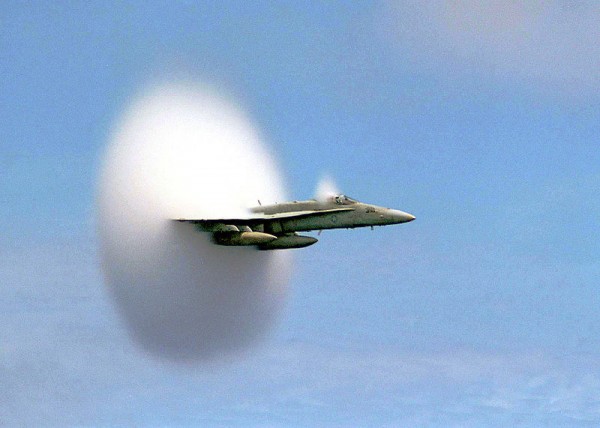
but it can immediately turn that liquid water into the special form of -- you guessed it -- hexagonal ice crystals!
And the turbulent motion of the airflow combined with these oddly-shaped crystals, with the Sun at just the right angle, combines to produce this spectacular rainbow effect! And that's the physics of where this rainbow comes from!

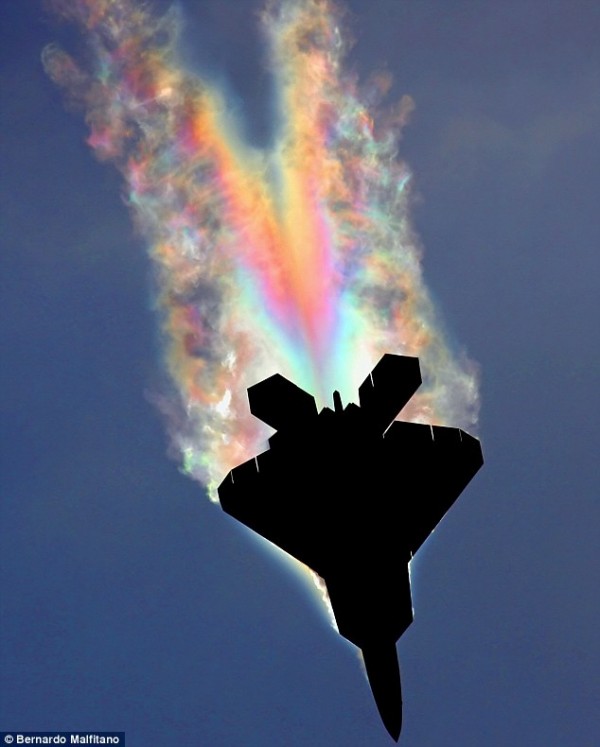

It is very cool that the plane makes the water vapor very cool.
Thanks for a lesson relatively easy to understand.
The quote is from Leonardo Da Vinci. Nice pics though, Thanks for sharing them.
Excellent post! I had seen photo's like that before, but never realised what was causing the rainbow.
@Tom, actually I think Ethan got it right. The quote (one of my favourite aviation quotes) is commonly attributed to da Vinci. However, no-one can actually point to a verifiable da Vinci source for it - see the comments on this website, and the author's attempts to verify the source (near the bottom) http://www.skygod.com/quotes/
How close to the speed of sound does a plane have to get for this to happen? I've seen this happen with 747s, which have a maximum speed of 0.85 Mach.
That's awesome!
It reminds me a little of the pictures of the STS-131 launch.
http://www.spaceweather.com/swpod2010/05apr10/Michael-Fertic1.jpg?PHPSE…
Awesome! Thank you. I love stuff like this.
as always, Ethan, cool pics and great explanation.
The Fire Rainbow happens when you have high-altitude sunlight (58 degrees or higher)
do you mean high-latitude? (otherwise the parens should say "150 million kilometers or higher" instead, right? :)
That's my favourite quote from Civilization 4.
This is awesome. The picture is awesome, the physics are awesome, and the explanation was awesome. I'd never been on your blog before, but I'm definitely coming back :)
Thanks for the insight, which i think is correct for most part, except the gist about it flying close to mach 1.
the condensation you see behind the Raptor in this photo I believe stems from low pressure being rapidly equalized as you mention, but not because of high speed but because of high Angle of Attack.
The shot is probably taken from the ground and during a (relatively) slow maneuver where the aircraft pulls hard up, causing the flow of air to become almost perpendicular to the alignment of the wings, which will cause said large pocket of low pressure which rapidly is equalized causing condensation of the water vapor in the air.
You can actually often see this happening in standard jet airliners on approach with flaps (on the trailing edge of the wings) full extended (pointing down and being almost perpendicular to the motion of air). When the aircraft hits certain speeds, the water vapour will condensate over and behind the flaps causing what looks like flashes of small clouds instantly appear and disappear.
I once had a fellow passenger sitting at the window seat freaking out due to this phenomenon, thinking the wing was blowing up...
I think you are very close, but one of the key elements of the effect that you are referencing is the orientation of the crystals. If the turbulent air behind the plane is causing the crystals to be randomly oriented, then the effect should be a white halo. (The circumhorizon effect, "Firerainbow", is most commonly caused by flat hexagonal crystals oriented with their largest face parallel to the ground.) I think the effect is most similar to Iridescent Clouds because the turbulence behind the plane would not interfere with the relative orientation of the spherical water droplets. http://www.atoptics.co.uk/droplets/irid1.htm
Ethan, I think Steffan is right. The condensation here is more likely due to high angle of attack. It's basically the same principle, where angle of attack creates a low pressure area behind the direction of travel and a high pressure area ahead. As angle of attack increases, lift increases which also has the byproduct of drag which creates the turbulent flow behind the flight surface. The aircraft in the photo above was likely traveling at less than 300 kts. If it were approaching the speed of sound, the entire rear half of the aircraft would be enveloped in a smooth cone of condensation, not turbulent airflow rippling off the flight surfaces.
I often see a similar effect at the edges of clouds around here (Sierra Nevada mtns). It's more of a mother-of-pearl effect than a rainbow, and easier to see if you're wearing sunglasses - otherwise the brightness of the sun swamps the colors.
There may be one additional factor. Judging from the color saturation I'd guess this was shot with a polarizing filter.
@James#15: That would be iridescent clouds. They'll be white and fluffy like typical clouds but have a nice rainbow patch on the edge.
I wouldn't believe too many claims on that "top 10 strangest natural phenomena"; for example numerous spontaneous human combustion claims have been shown to be false and despite claims on the site, there is no credible evidence for spontaneous animal combustion (well, except perhaps for small insects near a forest fire). The description of the green flashes is also dead wrong, although the photographs look genuine enough. Note that there are clouds in the photograph (in contrast to the claim in the caption that the atmosphere must be cloud-free). At least the lower atmosphere must be pretty clear of aerosols; even Minnaert stated that the northern hemisphere in general had become so polluted by the 1950s that the green flash was becoming a more rarified phenomenon. Moonbows don't need a waterfall (though as with rainbows, they're often a good place to spot one). Conditions for a moonbow are the same as for a rainbow; due to the low light level you probably won't see any color in it though.
I'm also going to say that it's not ice crystals, manifesting a color because of their common orientation to both other crystals and to the sunlight.
Iridescent clouds, or Mie scattering looks like the best explanation to me.
I also dint think these photos are taken when the airplane is moving at high speed. Notice in the high speed photos how the affected area is large in all directions. Plus, in the photo (#2) of the Raptor moving fast, there are noticeable wingtip vortices present, not in the rainbow photos.
@10 - You beat me to it :) I am always gratified when I have the opportunity to quote Leonard Nimoy's pithy technology advancement quotes to clients, and having the opportunity to do the same on one of my favorite blogs would've been an extra-special treat.
Oh, what the hell: "A designer knows he has achieved perfection not when he has nothing left to add, but when he has nothing left to take away."
Definitely not a rainbow of any sort, fire or otherwise.
A rainbow is a caustic at a fixed angle to the sun-- but the iridescence behind this airplane doesn't have a fixed angle to the sun-- in fact, the main part is V shaped.
I'm guessing cloud iridescence (water particles so small that they cause interference). But another thought is maybe some form of natural Schlieren pattern.
Double rainbow - oh my god! It's a double rainbow all the way
I agree with Steffen about the speed and AOA.
To distinguish between iridescence from diffraction and refraction on ice crystals, I think we should make a rough estimate of the temperature in the low pressure side. My guess is that it is not enough to freeze the water so quickly. To start with, we have to estimate the pressure above the wings and the weather conditions of free air.
I read that the wing area of the Raptor is 78 m^2. Supposing a 30,000 kg of weight, that leads to a delta-p for steady flight of: 300,000 N / 78 m^2 = 3,850 Pa. Suppose the maneuver is at 5g, we have to multiply this delta p times 5, so 19,250 Pa. This is the *average* delta-p across the bottom and the top of the wings. Since we search for the peak pressures, I will neglect the lower side overpressure, and say that we have about 20 kPa underpressure on the top side of the wing. May add local effects, say 30 kPa (atmospheric pressure at sea level is about 101,3 kPa).
Ok, now the weather. Please double check, but it looks like the air show has been held on the 2nd of October 2008 in Miramar. (Guess what, Miramar is a radisonde station, LOL). So on that day temperature was about 25°C, even at 1000 m (3000 ft). Now, with an adiabatic expansion from say p=95,000 Pa to p=65,000 Pa I get a temperature decrease from 25°C to -5°C (please double check, I hate those exponents :-). Below zero for sure, but not enough, IMHO, to generate ice so quickly.
I vote for the diffraction.
PS the objection that the hexagonal crystals must be oriented is not a problem: only the correctly oriented crystals (in the bunch of all possible orientations) will provide the effect, while the wrongly oriented ones will be nearly transparent or, worst case, a white fog. I don't think that in the upper troposphere the crystals are oriented.
2Ary:
Basically an airflow has different speeds on different parts of a plane. On some surfaces it can be higher or slower than 0.85M (if we talk about 747s). Add different atmospheric pressure that makes difference too (lower pressure - bigger chance of evaporation). Plus don't forget about humidity. It makes a difference too. The sum of all these factors allows to see effect even on relatively low speeds.
I see a couple of other people had mentioned cloud iridescence in the comments before I commented. Sorry; shoulda read the comments in more detail before posting.
Actually, another way to realize it's not a rainbow is simply that the colors are in the wrong order. Light blue, dark blue, brick red, orange, yellow? No. It's probably a higher order interference.
Dan mentions a polarizing filter, Geoffrey mentions a Schlieren pattern. I think it may be a combination of both. The Schlieren pattern made visible by the polarizing filter. the Schlieren pattern shows changes in the density or refractive index of the transparent medium, the air. The "V" mentioned by Geoffrey is also significant. It appears to emanate from one engine nozzle. My guess is that the plane is operating on one engine, possibly in afterburner and that what we are seeing is a Schlieren pattern of the effect of exhaust of that engine which would include big pressure changes and possibly unburned hydrocarbons and water vapor.
Bernardo Malfitano's photo was published on 7 September in the U.K. Daily Mail: Refraction action: Stunning rainbow pictured in trail of F-22 fighter jet. Additional contextual information there about the photo, including a video from the airshow, corroborates many of the previous commenters.
I think that the key is the polarizing filter on the camera. My first impression was that this was destructive interference (complementary colors and order...completely wrong for refraction) and the shape of the color bands goes with that as well. Ice is a dielectric, so reflected light is polarized parallel to the surface. Looks like birefringence with ice crystals to me.
i never understood what was causeing that. I thank you for helping me understand
i have seen these before but i never knew what they were
Would this same situation occur with any aircraft that was quickly maneuvering through the same angle of attack?
Does this depend upon the speed of the aircraft?
This is realy cool but why are the ice crystals in the shape of a hexagon
datz realy amazing fact but how this plane cn reach at that speed of forming this rainbow